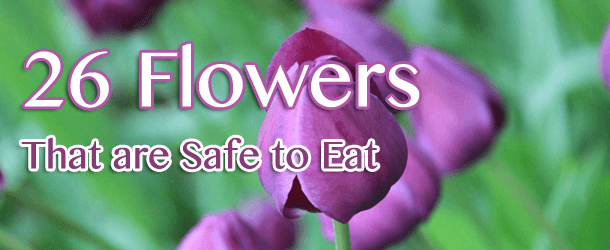
Edible flowers are back in vogue, gracing the covers of glossy food magazines and adding panache to restaurant entrees. Today’s flower cookery revival is defined less by “glam” than the move toward local and sustainable food options, consumers growing their own fresh produce, and more adventurous cooking ingredients. Flowers add color, texture, and vibrancy to any dish, not to mention enlivened conversation.
This blooming trend can be traced back through human history for thousands of years to the Romans, Chinese, Middle Eastern and Indian cultures. In fact, flower cookery was especially popular in Victorian times, when flowers such as violets, primroses, and nasturtiums were common in salads, pickled for winter storage, and candied for special occasion garnishes.
Feasting on Flowers
You may not be aware that you probably already eat many flowers, such as broccoli and cauliflower heads, capers, and saffron. But when you’re dining on garden-variety flowers, only the petals are typically ingested, with the exception of pansies, violets, and Johnny-jump-ups. Generally, the interior parts, such as pistils and stamens, are removed before eating.
Beware of Poisonous Flowers
For unfamiliar flowers, be sure they are edible before you partake, as some, such as delphinium or foxglove, are poisonous. Many more flowers are unsafe to eat than safe, so if there’s any doubt, consult a credible reference such as the American Medical Association (AMA) “Handbook of Poisonous and Injurious Plants.”
Also important to know is how a flower is grown. Never eat flowers exposed to pesticides or other chemicals, which may include those harvested roadside, grown in home gardens, or available from florists, nurseries or garden centers. These flowers are not grown for consumption and may have been exposed to untreated manure and pesticides not labeled for food crops. Fortunately, organically grown edible flowers are becoming more common in the produce sections of grocery stores.
Flowery Tase Test
Culinary trial is important when it comes to flower cookery. Try pairing sweet or floral scented blossoms with a dessert or cool drink, or peppery nasturtiums with a salad. Pick edible flowers (grown in safe conditions) in the early morning, when their water content is highest. Shake to free of hidden insects before washing in cool water. Drain and dry thoroughly on an absorbent towel before use. Preserve whole flowers refrigerated in a glass of water overnight or seal in plastic with a damp paper towel.
Safe Edible Flowers
Pick these posies to brighten your favorite dishes:
1. Bachelor’s button
2. Calendula
3. Chrysanthemum
4. Dandelion
5. Daylily
6. Dianthus
7. English daisy
8. Hibiscus
9. Hollyhock
10. Honeysuckle
11. Johnny-jump-up
12. Lavender
13. Lilac
14. Marigold
15. Nasturtium
16. Pansy
17. Passion flower
18. Pineapple sage
19. Red clover
20. Rose
21. Scented geraniums
22. Signet marigold
23. Snapdragon
24. Sunflower
25. Tulip
26. Violet
– Environmental Nutrition
Source: North Carolina State University Cooperative Extension
(Reprinted with permission from Environmental Nutrition, a monthly publication of Belvoir Media Group, LLC. 800-829-5384.www.EnvironmentalNutrition.com.)

